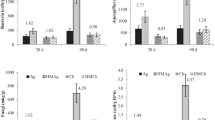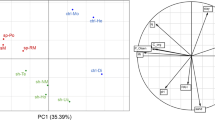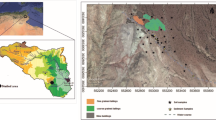Abstract
Gold mines are widely recognized as important sources of arsenic (As) pollution and this work proposes the use of in situ microbial community enzymatic response to assess the risk of As in soil and sediments surrounding “Morro do Ouro,” the largest industrial gold mine in Brazil. Bacterial community exposed to high metals concentrations deviates energy from growth to cell maintenance modifying enzymatic activity response. Even if the number of bacterial cells presented in soil and sediment samples was in the same order of 107 cell cm−3, it declines in sediment samples closer to a mining area. Dehydrogenase activity (DHA) showed the same trend, suggesting inhibition by toxic effect of metals, while esterase activities (EST) behaved in the opposite way, representative of increasing energy demand by the community under environmental stress. The Quality Ratio (QR) index for environmental risk assessment was applied to integrate geochemical (grain size, total organic carbon contents, and metals as indicators of complex contamination) and microbial parameters (DHA—energy production into cell and EST—hydrolase organic matter outside the cell membrane). QR indicated that the risk associated with soil and sediment is driven by As levels and decreases from the mine facilities.

Similar content being viewed by others
References
Allison, S. D., & Martiny, J. B. H. (2008). Resistance, resilience, and redundancy in microbial communities. Proceedings of the National Academy of Sciences, 105, 11512–11519. https://doi.org/10.1073/pnas.0801925105.
ATSDR - Agency for Toxic Substances and Disease Registry - US. (2007) Agency for toxic substances and disease registry. Toxicological profile for arsenic. Atlanta
Babich, H., & Stotzky, G. (1985). Heavy metal toxicity to microbe-mediated ecologic processes: a review and potential application to regulatory policies. Environmental Research, 36, 111–137.
Bidone, E. D., Castilhos, Z. C., Bertolino, L. C., Santos, M. C. B., Silva, R. S. V., & Cesar, R. G. (2014). Arsenic in soils and sediments from Paracatu, Brazil. In M. I. Litter, H. B. Nicolli, J. M. Meichtry, N. Quici, J. Bundschuh, P. Bhattacharya, & R. Naidu (Eds.), V international congress of arsenic in the environment – As2014 (pp. 113–115). Proceedings: Buenos Aires, Argenina, CRC Press-Taylor and Francis Group.
Bidone, E. D., Castilhos, Z. C., Cesar, R. G., Santos, M. C., Sierpe, R., & Ferreira, M. (2016). Hydrogeochemistry of arsenic pollution in watersheds influenced by gold mining activities in Paracatu (Minas Gerais State, Brazil). Environmental Science and Pollution Research, 23(9), 8546–8555. https://doi.org/10.1007/s11356-016-6089-3.
Bidone, E. D., Cesar, R. G., Santos, M. C., Sierpe, R., Silva-Filho, E. V., Kutter, V., et al. (2018). Mass balance of arsenic fluxes in rivers impacted by gold mining activities in Paracatu (Minas Gerais State, Brazil). Environmental Science and Pollution Research, 25, 9085–9100. https://doi.org/10.1007/s11356-018-1215-z.
Bowell, R. J., Alpers, C. H., Jamieson, H. E., Nordstrom, D. K., & Majzlan, J. (2014). The environmental geochemistry of arsenic—an overview. Reviews in Mineralogy & Geochemistry, 79, 1–16.
Busch, J., Nascimento, J. R., Magalhães, A. C. R., Dutilh, B. E., & Dinsdale, E. (2015). Copper tolerance and distribution of epibiotic bacteria associated with giant kelp Macrocystis pyrifera in southern California. Ecotoxicology, 24, 1131–1140. https://doi.org/10.1007/s10646-015-1460-6.
Caruso, G., La Ferla, R., Azzaro, M., et al. (2016). Microbial assemblages for environmental quality assessment: knowledge, gaps and usefulness in the European marine strategy framework directive. Critical Reviews in Microbiology, 42(6), 883–904. https://doi.org/10.3109/1040841X.2015.1087380.
CETEM - Centro de Tecnologia Mineral (2018) Relatório Final- Ambiental “Avaliação da Contaminação Ambiental por Arsenio em Paracatu-MG”. Available at: <https://www.cetem.gov.br/images/gestao/relatorio_paracatu_ambiental_2018_cetem.pdf>. Accessed June 2020.
CONAMA - Conselho Nacional de Meio Ambiente (2009) Resolução 420. Available at: <http://www.mma.gov.br/port/conama/legiabre.cfm?codlegi=506>. Accessed September 2019.
CONAMA - Conselho Nacional do Meio Ambiente (2012) Resolução 454. Available at: <http://www2.mma.gov.br/port/conama/legiabre. cfm?codlegi=693>. Accessed September 2019.
Cornall, A., Rose, A., Streten, C., McGuinness, K., Parry, D., & Gibb, K. (2016). Molecular screening of microbial communities for candidate indicators of multiple metal impacts in marine sediments from northern Australia. Environmental Toxicology and Chemistry, 35, 468–484. https://doi.org/10.1002/etc.3205.
Craw, D., & Bowell, R. J. (2014). The characterization of arsenic in mine waste. Reviews in Mineralogy & Geochemistry, 79, 473–505.
Decho, A. W. (2000). Microbial biofilms in intertidal systems: an overview. Continental Shelf Research, 20, 1257–1273.
Demaison, G. J., & Moore, G. T. (1980). Anoxic environment and oil source bed genesis. Organic Geochemistry, 2, 9–31.
EMBRAPA - EMPRESA BRASILEIRA DE PESQUISA AGROPECUÁRIA (1997). Manual de métodos de análises de solo. Rio de Janeiro, RJ, p 212.
Fabiano, M., Danovaro, R., Magi, E., & Mazzucotelli, A. (1994). Effects of heavy metals on benthic bacteria in coastal marine sediments: a field result. Marine Pollution Bulletin, 28, 18–23. https://doi.org/10.1016/0025-326X(94)90181-3.
Fiori, C. S. F., Rodrigues, A. P. C., Santelli, R. E., et al. (2013). Ecological risk index for aquatic pollution control: a case study of coastal water bodies from the Rio de Janeiro state, southeastern Brazil. Geochimica Brasiliensis, 2, 24–36. https://doi.org/10.5327/Z0102-9800201300010003.
Flemming, H. C. (2016). EPS—Then and now. Microorganisms, 4, 41. https://doi.org/10.3390/microorganisms4040041.
Flemming, H. C., & Wingender, J. (2010). The biofilm matrix. Nature Reviews Microbiology, 19, 139–150. https://doi.org/10.1038/nrmicro2415.
Guo, W., Liu, X., Liu, Z., & Li, G. (2010). Pollution and potential ecological risk evaluation of heavy metals in the sediments around Dongjiang Harbor, Tianjin. Procedia Environmental Sciences, 2, 729–736. https://doi.org/10.1016/j.proenv.2010.10.084.
Hakanson, L. (1980). An ecological risk index for aquatic pollution control. A sedimentological approach. Water Research, 14, 975–1001. https://doi.org/10.1016/0043-1354(80)90143-8.
Harrison, J. J., Ceri, H., & Turner, R. J. (2007). Multimetal resistance and tolerance in microbial biofilms. Nature Reviews Microbiology, 5, 928–938. https://doi.org/10.1038/nrmicro1774.
Henderson, R. D. (2006). Paracatu mine technical report. Kinross Gold Corporation, Technical Report.
IBGE (2010) Censo Demográfico – Características Gerais da População. Resultados da Amostra. IBGE, 2012. Available at: https://censo2010.ibge.gov.br/resultados.html. Accessed September 2019.
Meyer-Reil, L. A., & Köster, M. (2000). Eutrophication of marine waters: effects on benthic microbial communities. Marine Pollution Bulletin, 41, 255–263.
Miao, L., Wang, C., Hou, J., Wang, P., Ao, Y., Li, Y., Yao, Y., Lv, B., Yang, Y., You, G., Xu, Y., & Gu, Q. (2017). Response of wastewater biofilm to CuO nanoparticle exposure in terms of extracellular polymeric substances and microbial community structure. Science of the Total Environment, 579, 588–597. https://doi.org/10.1016/j.scitotenv.2016.11.056.
Möller, J. C., Batelochi, M., Akiti, Y., Maxwell, S., & Borges, A. L. (2001). Geologia e caracterização dos recursos minerais de Morro do Ouro, Paracatu, Minas Gerais. In C. P. Pinto & M. A. Martins-Neto (Eds.), Bacia do São Francisco: geologia e recursos naturais (pp. 199–234). SBG: Belo Horizonte.
Moreau, J. W., Gionfriddo, C. M., Krabbenhoft, D. P., Ogorek, J. M., DeWild, J. F., Aiken, G. R., & Roden, E. E. (2015). The effect of natural organic matter on mercury methylation by Desulfobulbus propionicus 1pr3. Frontiers in Microbiology, 6. https://doi.org/10.3389/fmicb.2015.01389.
Mustapha, M. U., & Halimoon, N. (2015). Microorganisms and biosorption of heavy metals in the environment: a review paper. Journal of Microbial & Biochemical Technology, 7, 253–256. https://doi.org/10.4172/1948-5948.1000219.
Nascimento, J. R (2018). Integração de Indicadores Geoquímicos e Microbiológicos na Avaliação da Disposição Oceânica e Continental de Sedimentos Dragados da Baía de Guanabara – RJ, brasil. PhD. Thesis, Universidade Federal Fluminense.
Nascimento, J. R., Silveira, A. E. F., Bidone, E. D., & Sabadini-Santos, E. (2019). Microbial community activity in response to multiple contaminant exposure: a feasible tool for sediment quality assessment. Environmental Monitoring and Assessment, 191, 392. https://doi.org/10.1007/s10661-019-7532-y.
Nogales, B., Lanfranconi, M. P., Piña-Villalonga, J. M., & Bosch, R. (2011). Anthropogenic perturbations in marine microbial communities. FEMS Microbiology Reviews, 35, 275–298. https://doi.org/10.1111/j.1574-6976.2010.00248.x.
Obbard, J. P., Sauerbeck, D., & Jones, K. C. (1994). Dehydrogenase activity of the microbial biomass in soils from a field experiment amended with heavy metal contaminated sewage sludges. Science of the Total Environment, 142, 157–162. https://doi.org/10.1016/0048-9697(94)90323-9.
Odum, E. P. (1985). Trends expected in stressed ecosystems. Bioscience, 35, 419–422. https://doi.org/10.2307/1310021.
Relexans, J. C., Lin, R. G., Castel, J., et al. (1992). Response of biota to sedimentary organic-matter quality of the west Gironde mud patch, Bay of Biscay (France). Oceanologica Acta, 15, 639–649.
Sabadini-Santos, E., Silva, T. S., Lopes-Rosa, T. D., et al. (2014). Microbial activities and bioavailable concentrations of Cu, Zn, and Pb in sediments from a tropic and eutrothicated bay. Water, Air, and Soil Pollution, 225. 10.1007/s11270-014-1949-2.
Saxena, G., Marzinelli, E. M., Naing, N. N., He, Z., Liang, Y., Tom, L., Mitra, S., Ping, H., Joshi, U. M., Reuben, S., Mynampati, K. C., Mishra, S., Umashankar, S., Zhou, J., Andersen, G. L., Kjelleberg, S., & Swarup, S. (2015). Ecogenomics reveals metals and land-use pressures on microbial communities in the waterways of a megacity. Environmental Science & Technology, 49, 1462–1471. https://doi.org/10.1021/es504531s.
Silveira, A. E. F., Nascimento, J. R., Sabadini-santos, E., & Bidone, E. D. (2017). Screening-level risk assessment applied to dredging of polluted sediments from. Marine Pollution Bulletin, 118, 368–375. https://doi.org/10.1016/j.marpolbul.2017.03.016.
Sobolev, D., & Begonia, M. F. T. (2008). Effects of heavy metal contamination upon soil microbes: lead-induced changes in general and denitrifying microbial communities as evidenced by molecular markers. International Journal of Environmental Research and Public Health, 5, 450–456. https://doi.org/10.3390/ijerph5050450.
Stubberfield, L. C. E., & Shaw, P. J. A. (1990). A comparison of tetrazolium reduction and FDA\nhydrolysis with other measures of microbial activity. Journal of Microbiological Methods, 12, 151–162.
Trevors, J. T., Mayfield, C. I., & Inniss, W. E. (1982). Measurement of electron transport system (ETS) activity in soil. Microbial Ecology, 8, 163–168. https://doi.org/10.1007/BF02010449.
USEPA (2004). Innovative technology verification report: field measurement technology for mercury in soil and sediment. Ohio Lumex’s RA-915þ/RP-91C mercury analyser. EPA/600/R-03/147. 86.
USEPA (2007). Method 3051A: microwave assisted acid digestion of sediments, sludges, soils, and oils. 1–30.
Van Beelen, P., & Doelman, P. (1997). Significance and application of microbial toxicity tests in assessing ecotoxicological risks of contaminants in soil and sediment. Chemosphere, 34, 455–499. https://doi.org/10.1016/S0045-6535(96)00388-8.
Waite, C. C. D. C., da Silva, G. O. A., Bitencourt, J. A. P., Sabadini-Santos, E., & Crapez, M. A. C. (2016). Copper and lead removal from aqueous solutions by bacterial consortia acting as biosorbents. Marine Pollution Bulletin, 109, 386–392. https://doi.org/10.1016/j.marpolbul.2016.05.044.
Whitman, W. B., Coleman, D. C., & Wiebe, W. J. (1998). Prokaryotes: the unseen majority. Proceedings of the National Academy of Sciences, 95(12), 6578–6583. https://doi.org/10.1073/pnas.95.12.6578.
WHO – World Health Organization (2018) International programme on chemical safety. https://www.who.int/ipcs/en/ Accessed 26 April 2018.
Acknowledgments
The authors are thankful to Centro de Tecnologia Mineral (CETEM) for the technical and logistic support. The authors also appreciate the scientific discussion with Dr. Mirian Crapez from the Laboratorio de Processos em Ecologia Microbiana, Universidade Federal Fluminense.
Funding
This study was financed in part by the Coordenação de Aperfeiçoamento de Pessoal de Nível Superior – Brasil (CAPES) – Finance Code 001.
Author information
Authors and Affiliations
Corresponding author
Additional information
Publisher’s Note
Springer Nature remains neutral with regard to jurisdictional claims in published maps and institutional affiliations.
Rights and permissions
About this article
Cite this article
Sabadini-Santos, E., Castilhos, Z.C. & Bidone, E.D. Microbial Activities Response to Contamination in Soil and Sediments Rich in As Surrounding an Industrial Gold Mine. Water Air Soil Pollut 231, 366 (2020). https://doi.org/10.1007/s11270-020-04734-4
Received:
Accepted:
Published:
DOI: https://doi.org/10.1007/s11270-020-04734-4




